Cassiopeia A (Cas A) is the remnant of a supernova that occurred approximately 11,000 light-years away in the constellation Cassiopeia. The light from the supernova event reached Earth more than 300 years ago. The supernova that produced the remnant peaked at magnitude 6. It was the last supernova in the Milky Way to be visible to the unaided eye and is the youngest known supernova remnant in our galaxy.
Cassiopeia A appears around 10 light-years across from our perspective. The cloud of material expelled in the supernova event is expanding at 4,000 – 6,000 km/s. The expansion shell has an estimated temperature of about 30 million K. The expansion velocity and temperature were obtained in a 2006 study based on the observations with the Advanced Camera for Surveys (ACS) on the Hubble Space Telescope (HST).
The Hubble observations showed that the Cassiopeia A remnant is not expanding uniformly. Astronomers found that some high velocity knots were moving at 5,500 – 14,500 km/s. The highest expansion velocities were found in the knots in the nearly opposing northeast and southwest jets.
The supernova remnant will keep expanding for thousands of years. The expelled material will eventually disappear into the surrounding interstellar space, where it will be recycled as raw material for the formation of new generations of stars.
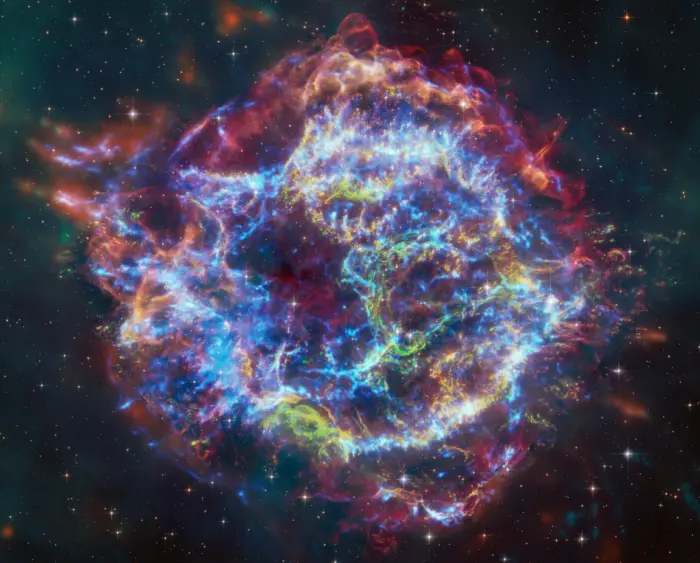
For the first time, astronomers have combined data from NASA’s Chandra X-ray Observatory and James Webb Space Telescope to study the well-known supernova remnant Cassiopeia A (Cas A). This work has helped explain an unusual structure in the debris from the destroyed star called the “Green Monster,” because of its resemblance to the wall in the left field of Fenway Park. By combining the Webb data with X-rays from Chandra, researchers have concluded that the Green Monster was created by a blast wave from the progenitor star slamming into material surrounding it. Detailed analysis found that filaments in the outer part of Cas A, from the blast wave, closely matched the X-ray properties of the Green Monster, including less iron and silicon than in the supernova debris. This interpretation is apparent from the color Chandra image, which shows that the colors inside the Green Monster’s outline best match with the colors of the blast wave rather than the debris with iron and silicon. Credit – X-ray: NASA/CXC/SAO; Optical: NASA/ESA/STScl; IR: NASA/ESA/CSA/STScl/Milisavljevic et al., NASA/JPL/CalTech; Image Processing: NASA/CXC/SAO/J. Schmidt and K. Arcand (PD)
At infrared and X-ray wavelengths, Cassiopeia A appears as a ring of expanding material about 5 arcminutes across.
Astronomers found that the central X-ray source of the supernova remnant appears around 7 arcseconds southeast of the estimated centre of expansion.
The remnant of the progenitor star that produced Cassiopeia A was detected by the Chandra X-ray Observatory in 1999. The compact object – a neutron star – was catalogued as CXOU J232327.8+584842. It was the first neutron star discovered to have a thin carbon atmosphere. In 2011, astronomers discovered that the stellar remnant was rapidly cooling.
The young neutron star does not show evidence of X-ray pulsation and does not have a counterpart in the optical and infrared bands. No X-ray pulsar wind nebula has been detected around it.
In 2005, astronomers used the Spitzer Space Telescope to observe an infrared echo of the Cassiopeia A supernova event on the nearby gas clouds. The infrared echo is believed to be caused by thermal dust emission. The dust was heated by the shock of the expanding supernova.
The infrared echo has an optical counterpart, a scattered light echo. The spectrum of the light echo confirmed that the event that produced Cassiopeia A was a type IIb supernova.
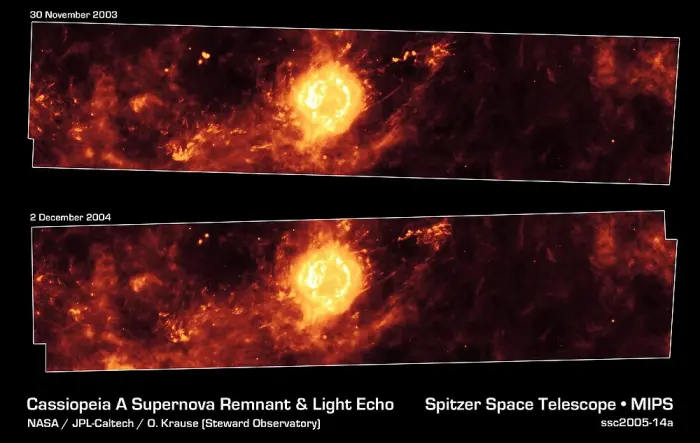
These Spitzer Space Telescope images, taken one year apart, show the supernova remnant Cassiopeia A (yellow ball) and surrounding clouds of dust (reddish orange). The pictures illustrate that a blast of light from Cassiopeia A is waltzing outward through the dusty skies. This dance, called an “infrared echo,” began when the remnant erupted about 50 years ago. Infrared echoes are created when a star erupts or goes out as a supernova, flashing light into surrounding clumps of dust. As the light zips through the dust clumps, it heats them up, causing them to glow successively in infrared, like a chain of Christmas bulbs lighting up one by one. The result is an optical illusion, in which the dust appears to be flying outward at the speed of light. Echoes are distinct from supernova shockwaves, which are made up material that is swept up and hurled outward when stars meet their fiery ends. This infrared echo is the largest ever seen, stretching more than 50 light-years away from Cassiopeia A. Image credit: NASA/JPL-Caltech/O. Krause (Steward Observatory) (CC0 1.0)
Supernova
Cassiopeia A is the remnant of a type IIb supernova, one caused by an internal collapse of a massive star. Infrared observations of the remnant’s spectrum with the Spitzer Space Telescope strongly indicate a type II supernova.
The progenitor star was likely a red supergiant with a helium core that had lost most of its hydrogen envelope before meeting its spectacular end. The star is believed to have had a binary companion at some stage. Deep searches for the companion have not yielded any results, leading astronomers to conclude that the star was a low-mass dwarf or that the two stars merged before the supernova event.
The supernova that produced Cassiopeia A occurred in the Perseus Arm of the Milky Way galaxy, around 11,000 light-years from the Sun. Astronomers estimate that the light from the event first reached Earth in the late 17th century, giving the remnant an estimated age of only around 330 – 340 years. However, there are no known records of the supernova from then.
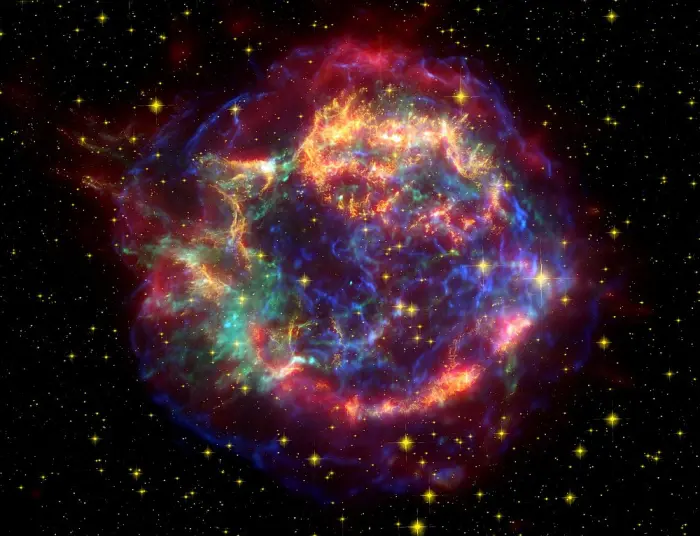
A false color image of Cassiopeia A (Cas A) using observations from both the Hubble and Spitzer telescopes as well as the Chandra X-ray Observatory (cropped). Image credit: NASA/JPL-Caltech, Oliver Krause (Steward Observatory) George H. Rieke (Steward Observatory) Stephan M. Birkmann (Max-Planck-Institut für Astronomie) Emeric Le Floc’h (Steward Observatory) Karl D. Gordon (Steward Observatory) Eiichi Egami (Steward Observatory) John Bieging (Steward Observatory) John P. Hughes (Rutgers University) Erick Young (Steward Observatory) Joannah L. Hinz (Steward Observatory) Sascha P. Quanz (Max-Planck-Institut für Astronomie) Dean C. Hines (Space Science Institute) (PD)
The light from the supernova may have been absorbed by interstellar dust. It is also possible that the progenitor star was exceptionally massive and expelled much of the material in its outer layers before going out as a supernova. The ejected material could have absorbed a significant portion of the visible light produced by the supernova event. The progenitor star had an estimated mass 15 to 20 times that of the Sun.
Calculations using the observed expansion rate of the remnant pointed to 1667 as the year the light from the supernova first reached Earth. However, observations with the Hubble Space Telescope have revealed that the remnant was not expanding in a uniform manner, with the highest velocities observed in two opposing jets. The light from the progenitor supernova of Cassiopeia A is believed to have first reached Earth at some point between 1662 and 1700.
The supernova event may have been recorded by the English astronomer John Flamsteed, who noted a sixth magnitude star, 3 Cassiopeiae, at the same position on August 16, 1680. Flamsteed catalogued the star, but no star was later found at this position, leading astronomers to speculate that the Astronomer Royal may have spotted a transient. Flamsteed’s recorded position of 3 Cassiopeiae was within 10 arcminutes of the Cas A radio source.
It is also possible that Flamsteed recorded the position of the star incorrectly. German astronomer Caroline Herschel proposed that an error in sextant readings may have caused Flamsteed to give an inaccurate position for the star HD 220562. Flamsteed may have also observed the variable star AR Cassiopeiae and given an incorrect position.
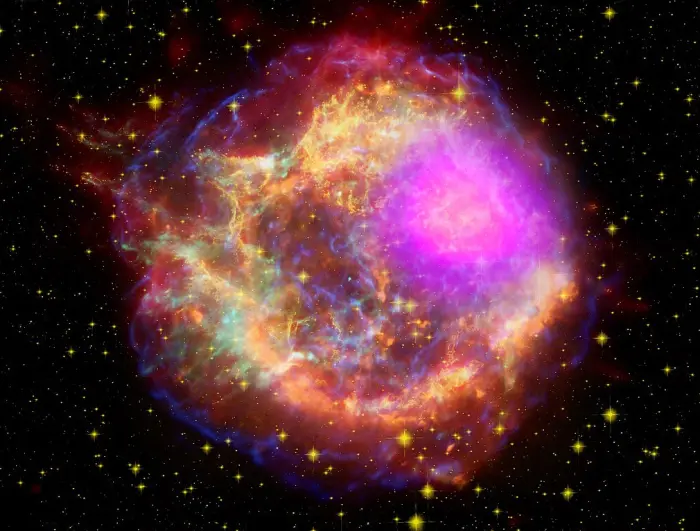
This composite shows the Cassiopeia A supernova remnant across the spectrum: Gamma rays (magenta) from NASA’s Fermi Gamma-ray Space Telescope; X-rays (blue, green) from NASA’s Chandra X-ray Observatory; visible light (yellow) from the Hubble Space Telescope; infrared (red) from NASA’s Spitzer Space Telescope; and radio (orange) from the Very Large Array near Socorro, N.M. Credit: NASA/DOE/Fermi LAT Collaboration, CXC/SAO/JPL-Caltech/Steward/O. Krause et al., and NRAO/AUI (CC0 1.0)
In 2011, British astronomer Martin Lunn and American historian Lila Rakoczy suggested that Cassiopeia A was the “noon day star” reportedly seen in 1630. The star is said to have heralded the birth of King Charles II, appearing in the sky on May 19, 1630, when the future monarch was born.
While the records were written decades after the event and are not entirely credible, Lunn and Rakoczy uncovered a book called Britanniae Natalis (1630), written by over 100 academics, that gives an account of the king’s birth. The finding is controversial because it challenges the current method for dating supernovae (based on their expansion rates) and the currently accepted distance to Cas A.
Cassiopeia A is catalogued as 3C 461 in the Third Cambridge Catalogue of Radio Sources and as G111.7-2.1 in the Green Catalog of Supernova Remnants.
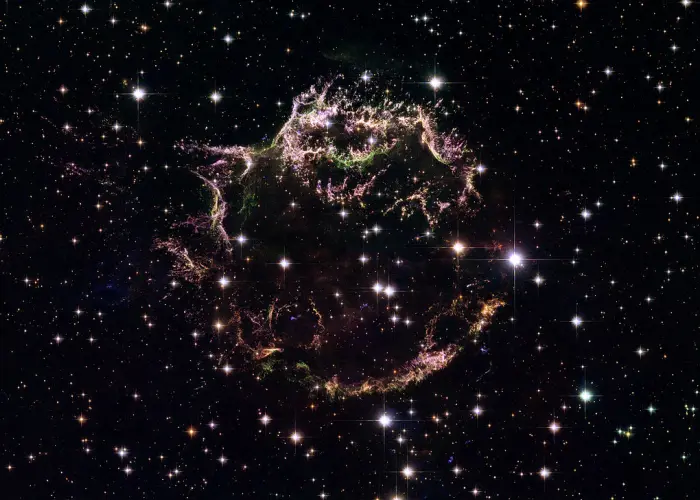
This is an image taken with the NASA/ESA Hubble Space Telescope that provides a detailed look at the supernova remnant Cassiopeia A (Cas A). The image shows the complex and intricate structure of the star’s shattered fragments. This image was captured in 2004. Image credit: NASA, ESA, and the Hubble Heritage (STScI/AURA)-ESA/Hubble Collaboration. Acknowledgement: R. A. Fesen (Dartmouth College, USA) and J. Long (ESA/Hubble) (CC BY 4.0)
Facts
Cassiopeia A was one of the first discrete radio source discovered. It was detected by Cambridge astronomers Martin Ryle and Francis Graham-Smith in 1947. The astronomers used the Long Michelson Interferometer, a radio telescope interferometer built by Ryle, and reported the discovery of the radio source in the journal Nature. Ryle went on to win the Nobel Prize for Physics in 1974 for his pioneering work in radio interferometry.
The supernova remnant was identified optically in 1950. In 2011, astronomers confirmed that the remnant was asymmetric.
Cassiopeia A is the brightest radio source outside the solar system at frequencies above 1 GHz.
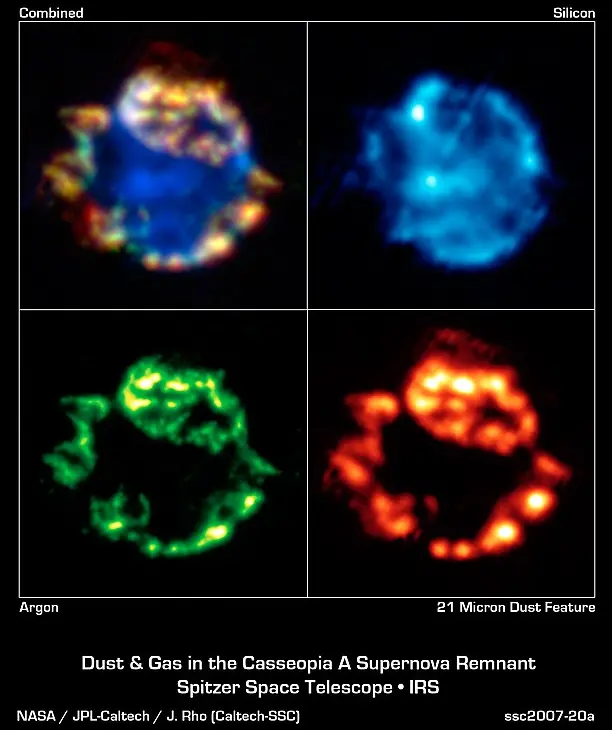
These beautiful bulbs might look like they belong on Christmas trees, but they are actually different Spitzer Space Telescope views of the supernova remnant Cassiopeia A. The upper left panel is a composite made up of three infrared views shown in the remaining panels. The bottom left view shows argon gas (green) that was synthesized as it was ejected from the star. The bottom right view shows a collection of dust (red), including proto-silicates, silicate dioxide and iron oxide. The fact that these two features line up (as seen in yellow in the combined view) tells astronomers that the dust, together with the gas, was created in the supernova event. This is the best evidence yet that supernovae are a significant source of dust in the early universe — something that was postulated before, but not proven. Dust in our young universe is important because it eventually made its way into future stars, planets and even people. The upper right panel shows silicon gas (blue) deep in the interior of the remnant. This cooler gas, called the unshocked ejecta, was also synthesized in the supernova event. The data for these images were taken by Spitzer’s infrared spectrograph, which splits light apart to reveal the fingerprints of molecules and elements. In total, Spitzer collected separate “spectra” at more than 1,700 positions across Cassiopeia A. Astronomers then created maps from this massive grid of data, showing the remnant in a multitude of infrared colors. Image credit: NASA/JPL-Caltech/J. Rho (Caltech-SSC) (CC0 1.0)
In 1980, the remnant had a flux density of 2720 ± 50 Jy at 1 GHz. Because Cassiopeia A is cooling as it expands, its flux density is decreasing at a rate of around 0.97 percent per year. For this reason, Cassiopeia A is now not as strong a source at frequencies below 1 GHz as Cygnus A (3C 405), a radio galaxy located in the constellation Cygnus.
Cassiopeia A was the first X-ray source discovered in the constellation Cassiopeia. It was detected by an Aerobee rocket flight on April 25, 1965. The source was catalogued as Cassiopeia X-1 or Cassiopeia XR-1. The instruments aboard the Aerobee rocket also detected X-ray emission the radio galaxies Messier 87 and Cygnus A, as well as from the X-ray source Cygnus X-1, believed to be a black hole.
In 2013, astronomers detected phosphorus in Cassiopeia A. The discovery confirmed that the element is indeed produced in supernova events. The phosphorus-iron ratio was up to 100 times higher in the material from the remnant than in the rest of the host galaxy, the Milky Way.
Cassiopeia A has been observed by most major space and ground-based telescopes, including the Hubble Space Telescope (HST), the Spitzer Space Telescope, the Chandra X-ray Observatory, and the James Webb Space Telescope (JWST).
In 2023, images taken by the James Webb telescope revealed new details of the expanding shell of gas colliding with the material expelled by the central star before it went out. In the mid-infrared, a loop of green light is visible in the remnant’s central cavity that cannot be seen in the near-infrared band. The curious feature has been nicknamed the Green Monster.
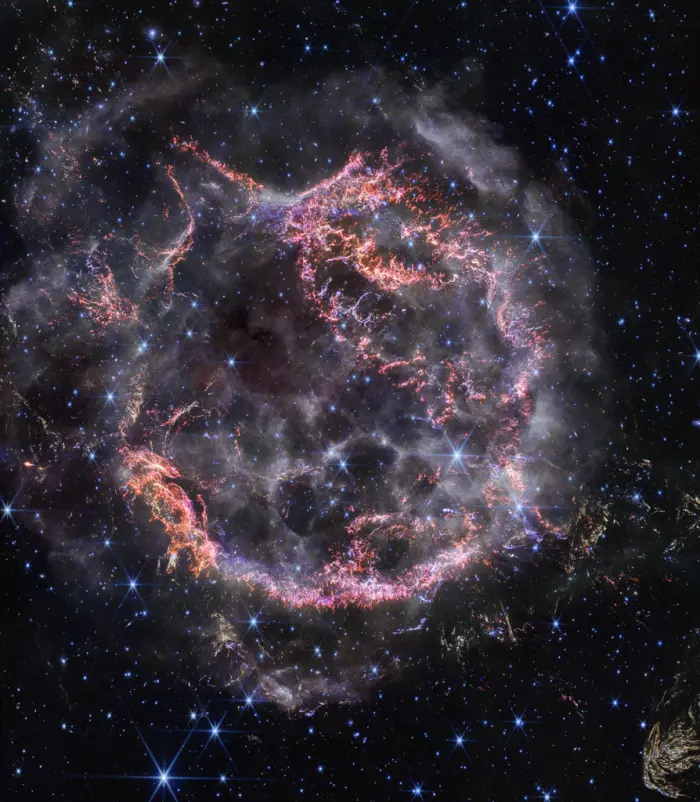
A new high-definition image from the NASA/ESA/CSA James Webb Space Telescope’s NIRCam (Near-Infrared Camera) release in December 2023 unveils intricate details of supernova remnant Cassiopeia A (Cas A), and shows the expanding shell of material slamming into the gas shed by the star before it went out. The most noticeable colours in Webb’s newest image are clumps of bright orange and light pink that make up the inner shell of the supernova remnant. These tiny knots of gas, comprised of sulphur, oxygen, argon, and neon from the star itself, are only detectable by NIRCam’s exquisite resolution, and give researchers a hint at how the star shattered like glass when it went out. The outskirts of the main inner shell looks like smoke from a campfire. This marks where ejected material from the star is ramming into surrounding circumstellar material. Researchers say this white colour is light from synchrotron radiation, which is generated by charged particles travelling at exceptionally high speeds and spiralling around magnetic field lines. There are also several light echoes visible in this image, most notably in the bottom right corner. This is where light from the star’s long-ago supernova event has reached, and is warming, distant dust, which glows as it cools down. Image credit: NASA, ESA, CSA, STScI, D. Milisavljevic (Purdue University), T. Temim (Princeton University), I. De Looze (University of Gent) (CC BY 4.0)
Webb’s NIRCam instrument has revealed a large blob that looks like an offspring of the main supernova. Nicknamed Baby Cas A, the blob is a light echo that lies some 170 light-years behind Cassiopeia A. It shows where the light of the supernova event is warming the dust and is one of several light echoes detected by Webb’s near-infrared eye.
The MIRI instrument showed new details in the supernova remnant’s inner shell that are invisible in the images taken by NIRCam.
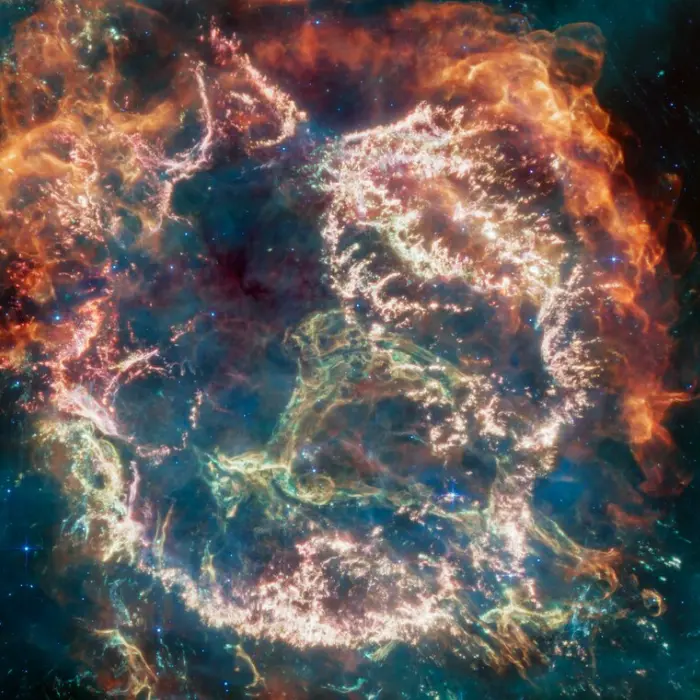
Cassiopeia A (Cas A) is a supernova remnant located about 11 000 light-years from Earth in the constellation Cassiopeia. It spans approximately 10 light-years. This image, released in April 2023, uses data from Webb’s Mid-Infrared Instrument (MIRI) to reveal Cas A in a new light. On the remnant’s exterior, particularly at the top and left, lie curtains of material, appearing orange and red, that are due to emission from warm dust. This marks where ejected material from the progenitor star is ramming into surrounding circumstellar material. Interior to this outer shell lie mottled filaments of bright pink studded with clumps and knots. This is material from the star itself, and likely shines due to a mix of various heavy elements and dust emission. The stellar material can also be seen as fainter wisps near the cavity’s interior. A loop represented in green extends across the right side of the central cavity. Its shape and complexity are unexpected and challenging for scientists to understand. Image credit: NASA, ESA, CSA, D. Milisavljevic (Purdue University), T. Temim (Princeton University), I. De Looze (UGent), J. DePasquale (STScI) (CC BY 4.0)
In 2024, a study led by Ilse de Looze of Sterrenkundig Observatorium, Ghent University, Belgium, confirmed that the Green Monster was associated with the circumstellar material expelled by the progenitor star during an asymmetric mass-loss phase. The discovery of the feature supports the hypothesis that the star underwent highly asymmetric mass loss before suffering core collapse and going out as a supernova. The study was published in The Astrophysical Journal Letters, Volume 976, in November 2024.
The Green Monster was found to contain dozens of circular holes about 1 – 3 arcseconds across. These holes were likely created by the interaction between the material ejected in the supernova event and the circumstellar material.
An X-ray analysis of the Green Monster has revealed significant blueshifting, indicating that the feature lies on the near side of Cassiopeia A, in front of the remnant.
Location
Cassiopeia A lies in the region between the constellation figures of Cassiopeia and Cepheus. It appears just east of the imaginary line connecting Caph and Zeta Cephei, about a third of the way from Caph to ζ Cep.
Caph is the rightmost star of Cassiopeia’s W and Zeta Cephei appears at the base of the stick house asterism that dominates the constellation Cepheus. The supernova remnant appears in the same region of the sky as the Bubble Nebula (NGC 7635) and the open cluster Messier 52.
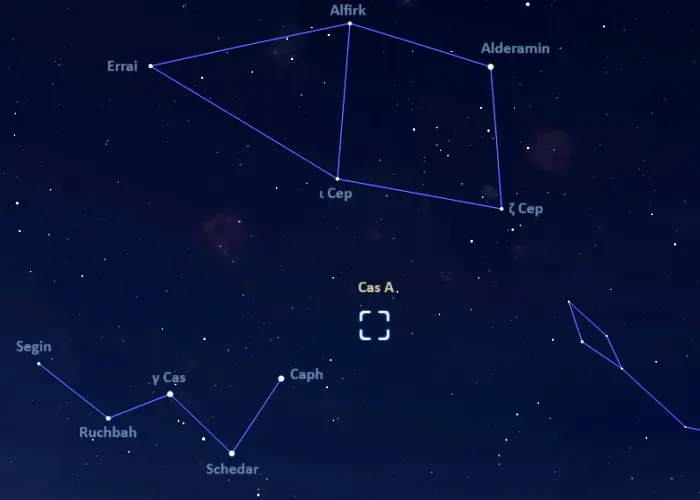
The location of Cassiopeia A, image: Stellarium
Cassiopeia A is a challenging target for small and medium telescopes. It can be spotted in 10-inch and larger instruments with filters. At declination +59°, the supernova remnant never rises for observers south of the latitude 31° S. In the northern hemisphere, the constellation Cassiopeia is circumpolar, i.e. visible throughout the year.
The best time of the year to observe Cassiopeia A and other deep sky objects in Cassiopeia is during the month of November, when the constellation appears higher above the horizon in the early evening.
Cassiopeia A
| Constellation | Cassiopeia |
| Right ascension | 23h 23m 24s |
| Declination | +58° 48′ 54′′ |
| Apparent magnitude (peak) | 6 (uncertain) |
| Apparent size | 5.0 x 5.0 arcminutes |
| Distance | 11,000 light years (3,400 parsecs) |
| Radius | 5 light-years (1.5 parsecs) |
| Names and designations | Cassiopeia A, Cas A, 3C 461, G111.7-2.1, 3A 2321+585, BWE 2321+5832, AJG 109, CTA 105, CTB 110, GAL 111.7-02.1, H 2334+60, CXOU J232327.9+584842, DA 601, DB 123, 2E 4724, 2E 2321.1+5833, NRAO 711, PBC J2323.3+5849, INTREF 1108, W 81, 3C 461, 3CR 461, 4C 58.40, 8C 2321+585, SN 1671, SN 1667, SN 1680, SNR G111.7-02.1, 1ES 2321+58.5, 1H 2321+585, SRGA J232326.0+584841, TeV J2323+588, 1FGL J2323.4+5849, 2FGL J2323.4+5849, 3FGL J2323.4+5849, 4FGL J2323.4+5849, 1FHL J2323.3+5849, 2FHL J2323.4+5848, 3FHL J2323.4+5848, 1RXS J232325.4+584838, SWIFT J2323.3+5849, SWIFT J2323.2+5848, 2U 2321+58, 3U 2321+58, 4U 2321+58 |
Images
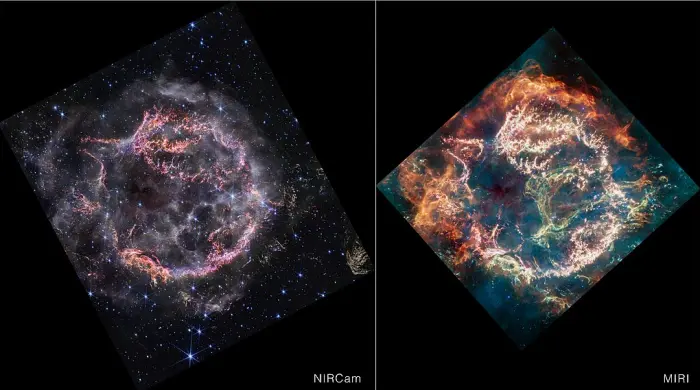
This image provides a side-by-side comparison of supernova remnant Cassiopeia A (Cas A) as captured by the NASA/ESA/CSA James Webb Space Telescope’s NIRCam (Near-Infrared Camera) and MIRI (Mid-Infrared Instrument). At first glance, Webb’s NIRCam image appears less colourful than the MIRI image. But this is only because the material from the object is emitting light at many different wavelengths The NIRCam image appears a bit sharper than the MIRI image because of its greater resolution. The outskirts of the main inner shell, which appeared as a deep orange and red in the MIRI image, look like smoke from a campfire in the NIRCam image. This marks where the supernova blast wave is ramming into surrounding circumstellar material. The dust in the circumstellar material is too cool to be detected directly at near-infrared wavelengths, but lights up in the mid-infrared. Also not seen in the near-infrared view is the loop of green light in the central cavity of Cas A that glowed in mid-infrared light, nicknamed the Green Monster by the research team. Credit: NASA, ESA, CSA, STScI, D. Milisavljevic (Purdue University), T. Temim (Princeton University), I. De Looze (University of Gent) (CC BY 4.0)
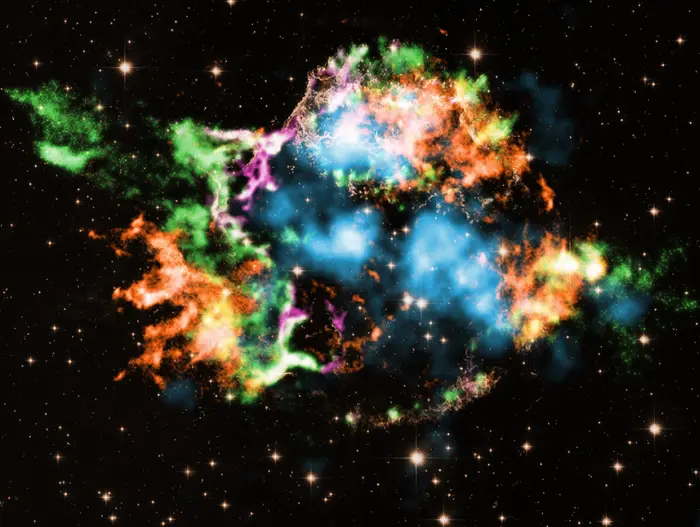
In 2021, astronomers using NASA’s Chandra X-ray Observatory have announced the discovery of an important type of titanium, along with other elements, blasting out from the center of the supernova remnant Cassiopeia A (Cas A). The different colors in this new image mostly represent elements detected by Chandra in Cas A: iron (orange), oxygen (purple), and the amount of silicon compared to magnesium (green). Titanium (light blue) detected previously by NASA’s NuSTAR telescope at higher X-ray energies is also shown. These Chandra and NuSTAR X-ray data have been overlaid on an optical-light image from the Hubble Space Telescope (yellow). Credit – Chandra: NASA/CXC/RIKEN/T. Sato et al.; NuSTAR: NASA/NuSTAR; Hubble: NASA/STScI (CC0 1.0)
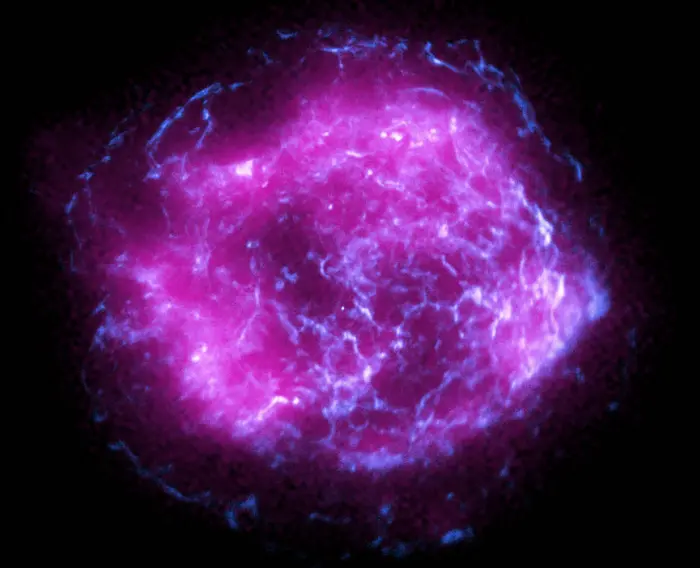
This image of the supernova Cassiopeia A combines some of the first X-ray data collected by NASA’s Imaging X-ray Polarimetry Explorer, shown in magenta, with high-energy X-ray data from NASA’s Chandra X-Ray Observatory, in blue. Image credit: NASA/CXC/SAO/IXPE (CC0 1.0)
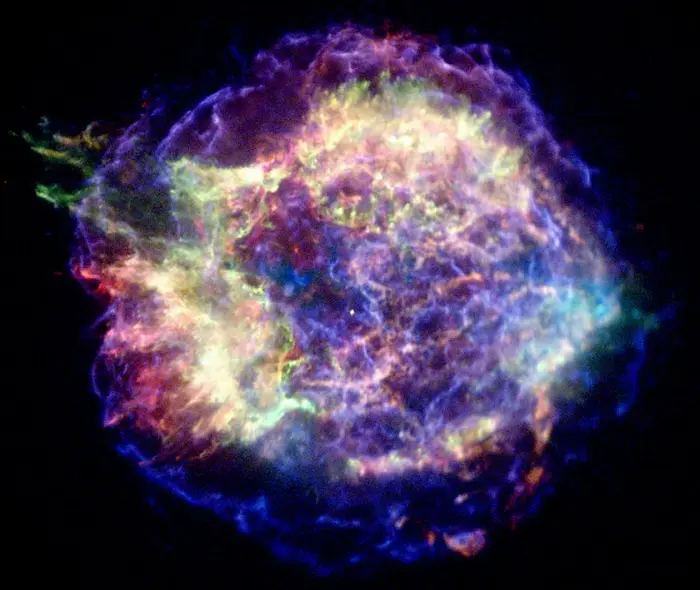
An analysis of an extraordinarily deep Chandra image of Cassiopeia A shows that this supernova remnant accelerates electrons to enormous energies. The blue, wispy arcs reveal the acceleration is taking place in an expanding shock wave generated by the supernova event that destroyed the progenitor star. This acceleration is close to the theoretical limit and provides strong evidence that supernova remnants are key sites for generating cosmic rays. Credit: ASA/CXC/MIT/UMass Amherst/M.D.Stage et al. (CC0 1.0)
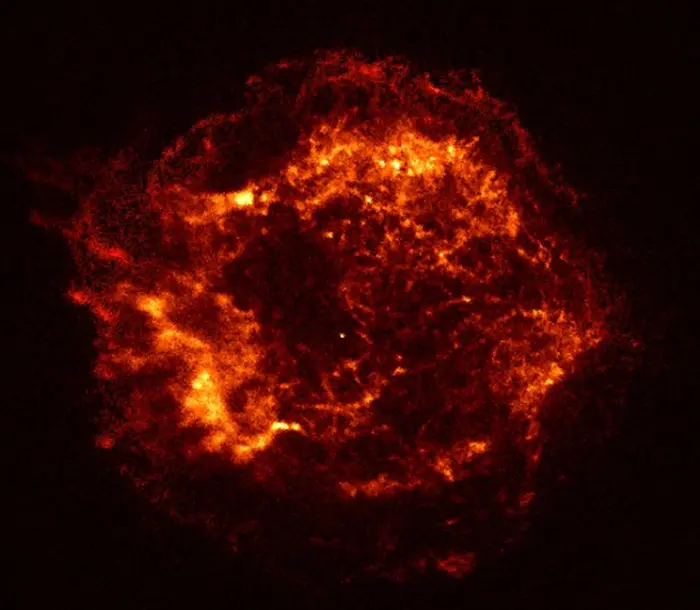
Chandra’s first light image of the Cas A supernova remnant. Image: NASA/CXC/SAO (CC0 1.0)
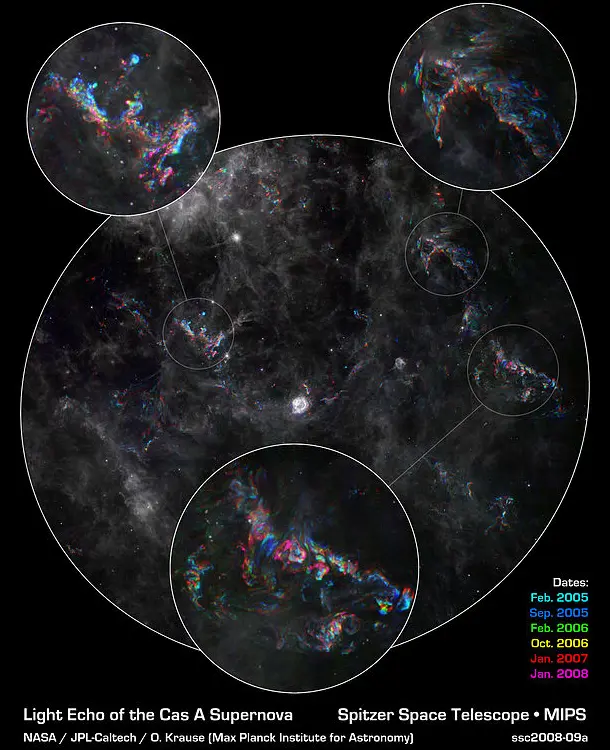
This image from NASA’s Spitzer Space Telescope highlights dramatic changes in phenomena referred to as light echoes (colored areas) around the Cassiopeia A supernova remnant (center). Credit: NASA/JPL-Caltech/Y. Kim (Univ. of Arizona/Univ. of Chicago) (PD)
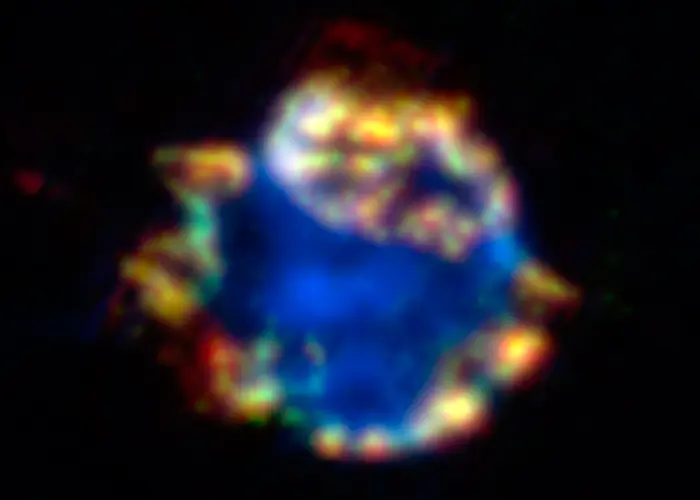
Cassiopeia A is shown here in an infrared composite from NASA’s Spitzer Space Telescope. Silicon gas is blue and argon gas is green, while red represents about 10,000 Earth masses worth of dust. Yellow shows areas where red and green overlap. Credit: NASA/JPL-Caltech/J. Rho (Caltech-SSC) (PD)
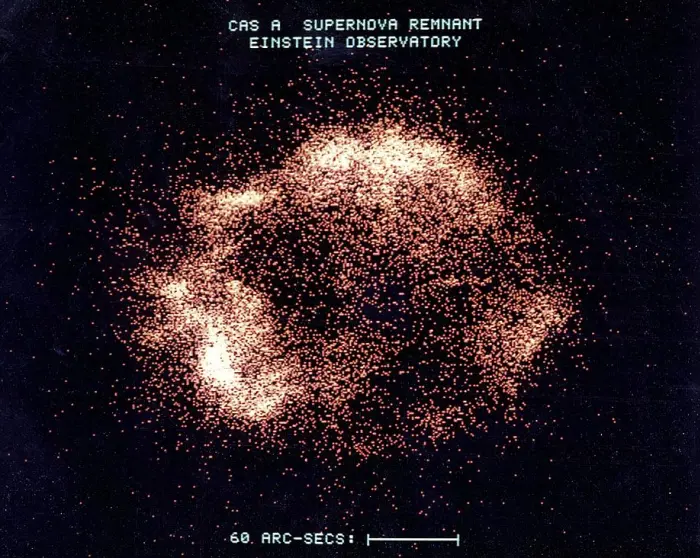
This X-ray photograph of the supernova remnant Cassiopeia A, taken with the High Energy Astronomy Observatory (HEAO) 2/Einstein Observatory in 1980, shows that the regions with fast moving knots of material in the expanding shell are bright and clear. A faint X-ray halo, just outside the bright shell, is interpreted as a shock wave moving ahead of the expanding debris. Image credit: NASA (PD)